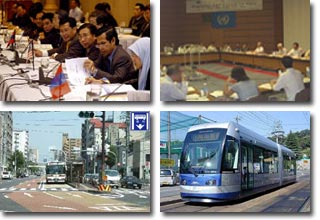
Environment and Transport
Transport is essential for social and economic activities. On the other hand, it has become one of the causes of environmental problems such as air pollution, noise, vibration, and emission of greenhouse gases.
Therefore, in addition to the current policy of Measures for Motor Vehicle Structure, it is necessary to bring new action plans such as transformation towards new lifestyles which do not rely on vehicles, and creation of city structures with low environmental loads.
What is EST?
Environmentally Sustainable Transport (EST) is a new policy vision that was proposed by the Organisation for Economic Co-operation and Development (OECD) and its commitment is to plan and implement policy on transport and environment based on a long-term perspective. By presenting the
specific vision for future transportation, it is expected to increase awareness and choose transport activities and lifestyles with reduced environmental loads.
(OECD EST Guidelines Japanese [PDF 97KB]/English [PDF 1,195KB] )
Ministry of the Environment, Government of Japan has been expanding its efforts to promote EST in Japan and in the Asian region.
Related Links
- Ministry of Land, Infrastructure and Transport, Government of Japan
- Environmentally Sustainable Transport(EST)(Japanese Only)
- Foundation for Promoting Personal Mobility and Ecological Transportation
- Environmentally Sustainable Transport(EST)Portal (Japanese Only)
- United Nations Centre for Regional Development(UNCRD)
- Environmentally Sustainable Transport(EST)Project
- Organisation for Economic Co-operation and Development (OECD)
- Environmentally Sustainable Transport (English only)